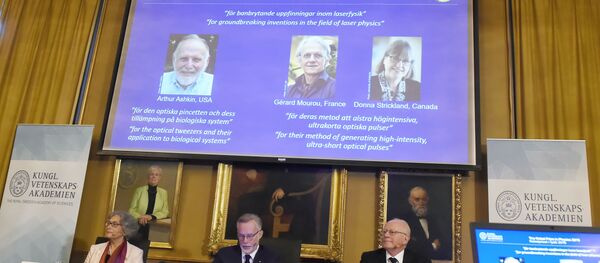What does he see as his main achievement in science? Can we expect experiments to ultimately answer the main questions of modern physics? Professor Ting spoke about this with Rossiya Segodnya Social Navigator correspondent Anna Kurskaya.
Anna Kurskaya: Professor Ting, you won the Nobel Prize for the discovery of a heavy elementary particle of a new kind, and this particle is one of the elements of the Standard Model. In the past years, scientists conducted many experiments in the LHC in order to register deviations from the Standard Model. However, no such deviations have been found so far. Do you think these deviations will ever be found? Or will the experiments only confirm the correctness of the Standard Model?
Samuel Ting: If an experiment only confirms the correctness of the Standard Model, it’s most unfortunate because the advance of physics is based on experiments that confront the theoretical model. Then physics advances.
Physics is basically an experimental science. A theory, however elegant, is meaningless if it cannot be proved by experiment. A theory can never disprove an experiment. If an experiment disproves a theory, you have a new theory.
You mentioned my work that led to the Nobel Prize in 1976. At that time, the Standard Model said that there are three quarks, u, d and s. And everybody believed that, mainly because it could explain all known physics phenomena. So people thought it was perfect.
READ MORE: The Shift: Physicists Refute Scientist’s Gender-Based ‘Pseudoscience’ at CERN
In 1972, I asked why are there only three quarks and decided to set up an experiment – a very, very sensitive experiment – to look for new phenomena. And the experiment was very unpopular because the theoretical community said: “This is nonsense because three quarks can explain everything.” The experimentalists said nobody could do such a difficult experiment because I required a sensitivity of one in ten billion. That is the equivalent when it’s raining in Moscow – ten billion drops of rain per second – of finding one red drop. And so most of the experimentalists said, “No, no, you will never find that.”
Now the Standard Model has six quarks. Of course, it explains all the existing phenomena and so far experiments have not found a contradiction. But this does not mean the model is correct. A hundred years from now, a larger accelerator may find differences. And so if you don’t do experiments, you will never know.
Anna Kurskaya: Besides the discovery of the J/psi meson, what do you think is your main achievement in science?
Samuel Ting: I did a few experiments. My first experiment was measuring the size of the electron.
In 1948, Richard Feynman, Julian Schwinger and Shinichiro Tomonaga developed a theory called quantum electrodynamics. According to that theory, the electron should have no measurable size. Though the theory was correct and they received a Nobel Prize, in 1964 there were experiments at Harvard and subsequently at Cornell showing that they do see a size.
At that time I was rather young, just got my degree. So I developed a method and found that no, those two experiments were wrong and the electron has no measurable size.
And so the question is: can photons go to this particle and can this particle go back to photons or not? The mass may not be important. It was a difficult experiment and I did show that yes, a photon can sometimes (the chances are very small, one in a million) go to massive particles, exactly like protons.
Another interesting thing I did was with Andrei Kunin, Vitaly Chutko and other Russian scientists from the Russian Academy of Sciences’ Institute for Theoretical and Experimental Physics (ITEP), and the Kurchatov Institute. For 20 years, we conducted an experiment at CERN where in a 27-kilometer electron-positron collider, we collided electrons and positrons, 100 bn eV each. The beam is very bright and very hot, equal to billions of electronvolts.
In that controlled experiment, we attempted to recreate the beginning of the Universe. That’s the best way to interpret it. So then we asked ourselves: how many quarks are there? How many electrons are there? Does the electron have a size? Is the Standard Model correct?
We found that the electron has no size. The size is less than 10-17 cm, a very small number. So I basically spent quite a substantial part of my life looking for the size of the electron and never found how small it is.
Unfortunately, the results of this 20-year experiment agree with the Standard Model so we have not learned anything new about it. When it is different from the Standard Model, we learn something new.
Anna Kurskaya: At the conference at MEPhI, you spoke about the results of the AMS experiment (Alpha Magnetic Spectrometer) at the International Space Station to measure the charge of cosmic rays. What is the purpose of this research?
Samuel Ting: There are two types of cosmic rays. One is light rays and neutrinos. They don’t carry mass. This has been studied exhaustively for nearly a century. Our entire understanding of space comes from that.
But then there are particles with charge: electrons, positrons, protons, antiprotons and elements on the periodic table. What are their properties? This has not been measured. And the reason it has not been measured is because we live under 100 km of atmosphere, which is equivalent to one meter of water. All those particles, because they carry charge, must have a mass, and when they go through the atmosphere they are absorbed or diffused, so you cannot find their original properties.
To find their original properties, you must go to space. But because some of these particles are positive and some are negative, to distinguish them you must have a magnet. Only in a magnet will positive and negative go opposite ways.
Putting a large magnet in space is not exactly easy. The space shuttle and the space station will lose control. But eventually, our Russian colleagues solved the problem and this is how a magnet spectrometer was put in space.
The AMS experiment has been conducted at the ISS for seven years now and will continue for as long as the station itself exists, until 2024 to 2028.
Anna Kurskaya: What did you find in the course of the experiment?
Samuel Ting: So far we have measured a great number of cosmic rays with extremely high energy up to 1020 eV. We found three or four interesting things.
First, the positron behaves in a very special way. This behavior as a function of energy indicates that positrons with low energy come from cosmic ray collision but high energy must have come from a source that could be a boson or dark matter collision. We have a lot of signals, two million events, so there is no question it comes from two different sources.
Second, for the electron we registered about 28 million events and found that low-energy and high-energy electrons come from different sources. So the electron and the positron have totally different behaviors in space.
We looked at primary cosmic rays such as helium, oxygen and carbon, and found that their momentum per unit charge called rigidity, the behavior, is exactly the same even though they have different mass.
We also found secondary cosmic rays. Those are the primary cosmic rays interacting with other cosmic rays to produce lithium, beryllium and boron. They have different rigidity dependence.
So in space there seems to be two classes of cosmic rays, the primary ones and the secondary ones. Their momentum per unit charge dependence is totally different: the primary rays exhibit one kind behavior and the secondary rays exhibit another kind. Those are the little interesting things.
Anna Kurskaya: You are the head of a great international collaboration that involves 500 physicists from all over the world. I know you have collaborated with Russian scientists. You are participating in a MEPhI conference. Is this related to your plans?
Samuel Ting: This is my second visit to MEPhI. Scientists from MEPhI are very good and we invited them to work with us. Earlier, they were involved in a very important international experiment called PAMELA and made a very important contribution. The AMS experiment is much larger and much more precise. PAMELA has stopped and it allowed them to continue their research with us. We are very hopeful that we will be able to work with them.
Russian physicists have made a huge contribution to particle physics and high energy physics. I have worked with the Kurchatov Institute since 1983. I think on average their standard is better than MIT physicists. And MIT is not a poor university. They have a very good standard.
Anna Kurskaya: Is this the most potentially successful way today for scientists to join big international groups and collaborations?
Samuel Ting: This is only my opinion but I think this is because we are not intelligent enough. We need collective intelligence. The best thing is to work by yourself. You do not have to argue or to discuss anything with people.
I often think about this problem, because when I started my career in high energy physics there were only four people in my group. Now there are several hundred. I talked about this problem with my daughter who is a biologist. It is not obvious to me that a young scientist will want to join a group of a thousand people. One of the problems is it is very hard for very good young people to distinguish themselves. I am actually quite worried about that.
Anna Kurskaya: What is the main question of fundamental physics today and when could it be resolved?
Samuel Ting: I am no qualified to say. People who make such predictions often regret it later on. I only want to say that in the 1930s, Japanese physicist Hideki Yukawa predicted the pi meson and strong nuclear forces between nucleons. In 1949, right after the war, he received a Nobel Prize, which was huge. And many physicists stood up and said: “Now we have understood everything. All the problems have been solved.” But that was only the beginning. We still have more to learn.
The interview took place at the 4th International Conference on Particle Physics and Astrophysics organized by MEPhI.







